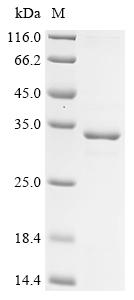The generation of the recombinant Mouse Muc4 protein involves manipulating gene expression in e.coli cells. A specific DNA sequence coding for the Mouse Muc4 protein (2712-2946aa) is inserted to an expression vector, which is then introduced into e.coli cells. The cells that successfully receive the vector are selected and cultured to induce the expression of the desired protein. A N-terminal 10xHis tag and C-terminal Myc tag is attached to the protein. The recombinant Mouse Muc4 protein undergoes affinity purification, achieving a purity level exceeding 85%, as verified through SDS-PAGE analysis.






